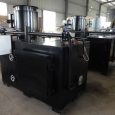The Post-Pandemic Surge in Medical Waste: Can Incineration Capacity Keep Up?
A Growing Global Concern
Since the COVID-19 pandemic, hospitals and clinics worldwide have faced an unprecedented rise in medical waste generation. Disposable masks, PPE, syringes, infusion bags, and contaminated plastics have overwhelmed traditional waste management systems. Countries that once relied on centralized treatment plants now struggle to process daily volumes of biohazardous waste safely.
This new reality raises a crucial question: Can incineration capacity keep up with the rapid increase in medical waste after the pandemic?
The Pressure on Healthcare Waste Systems
Medical waste volumes in Africa and Asia have more than doubled in several regions since 2020. Kenya, Tanzania, and Pakistan, for instance, report hospital incinerators operating near full capacity. In urban hospitals, autoclaves and small burners are insufficient for large quantities of contaminated material, leaving open burning or landfill disposal as unsafe last resorts.
To maintain hygiene and prevent disease resurgence, hospitals are urgently seeking industrial-grade incinerators for large-scale waste disposal, capable of maintaining combustion temperatures above 1100 °C for complete sterilization.
Learn more about industrial-grade incinerators
Modernizing Medical Waste Treatment
Modern medical waste incineration is no longer limited to simple combustion. Advanced technologies now include PLC-controlled dual-chamber systems, temperature monitoring, and wet scrubbers to neutralize acidic gases and remove visible smoke.
Companies such as HICLOVER have responded with custom-made medical waste incinerators for hospitals and clinics, integrating automatic feeding, secondary combustion, and air pollution control modules.
Explore customized incinerators for hospitals
For remote or emergency locations, containerized and mobile incinerators are proving essential. They can be deployed rapidly to humanitarian camps, mining zones, and regional hospitals lacking permanent infrastructure.
See containerized incineration solutions
The Role of Technology in Sustainability
The adoption of waste shredders and pre-treatment systems before incineration can significantly increase throughput and reduce fuel consumption. Shredded waste burns faster and more uniformly, lowering emissions while improving sterilization efficiency.
Applications of waste shredders in healthcare
Likewise, advanced wet scrubber systems and activated-carbon filters help meet emission standards aligned with EU and WHO recommendations, minimizing the environmental footprint of high-temperature operations.
Looking Ahead: Building Resilience
Post-pandemic healthcare demands are redefining waste management priorities. Hospitals and governments are now investing in scalable incineration systems that balance environmental sustainability, operational safety, and public health protection.
As the world moves toward better preparedness for future outbreaks, expanding and upgrading incineration capacity remains essential. Solutions like those offered by HICLOVER―combining high performance, automation, and emission control―are helping bridge the gap between growing waste volumes and sustainable healthcare operations.
For technical specifications and global project references, visit:
www.hiclover.com





